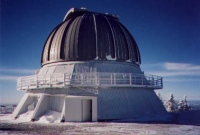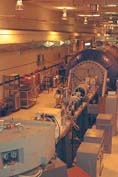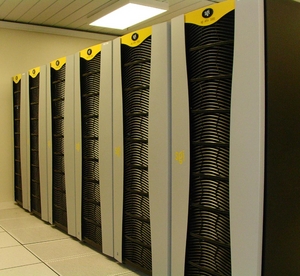Centres, groups, networks and laboratories
Astronomy and Astrophysics Group
The professors and researchers in the Astronomy and Astrophysics Group are interested in a broad range of research topics, from microscopic astrophysical processes all the way to the formation of galactic structures in the Universe. The Group’s research interests cover the major themes of modern astrophysics, involving both theoretical and observational studies: stellar astrophysics (white dwarfs, sub-dwarfs, massive stars), solar physics, brown dwarfs, extrasolar planets, high-energy astrophysics (x-ray sources, black holes, active galaxies, galactic clusters), galactic and extragalactic astronomy (interstellar environment, star formation, super-massive black holes, galactic evolution). Experimental astrophysics is another important aspect of the group’s activities, concerning the design and production of advanced astronomical instruments. Researchers in the Group not only use a variety of instruments in all wavelength domains (x-rays, ultraviolet, visible, infrared, submillimetre, radio) but are also actively involved in designing many of these instruments, some of them for major missions on Earth and in space, both present and future (e.g. the Thirty Meter Telescope and the James Webb Space Telescope).
The Université de Montréal and Université Laval jointly operate the Mont Mégantic Observatory (OMM). Boasting the largest telescope in eastern North America (1.6 m) and Canada’s only university astronomy observatory, the OMM is a valuable research and training tool. Its half-dozen instruments (many of them developed by the Group) make it particularly well equipped for imagery, spectroscopy and polarimetry in a wide range of wavelength domains, from the visible to infrared, and it is an ideal test bed for instrumentation, as well as providing observations used in the Group’s research. In addition to the OMM, the researchers use several other facilities worldwide, including the Canada-France-Hawaii telescope, the Gemini telescopes, the James Clerk Maxwell Telescope (JCMT), the instruments at the American national observatories at Kitt Peak (Arizona), Cerro Tololo (Chile), the Very Large Array radio interferometer (New Mexico) and various astronomical satellites such as Chandra, the XMM-Newton and Hubble.
With their colleagues at Laval, McGill and Bishop’s universities, the Group’s researchers belong to the Centre de recherche en astrophysique du Québec (CRAQ), funded by the Fonds de recherche du Québec - Nature et technologies (FRQNT) under its Strategic Clusters program. A number of FRQNT teams are also associated with the Group, and many of its researchers also belong to the Institute for research on exoplanets (IREx), founded for the purpose of benefiting as much as possible from major current and upcoming observation projects, with the ultimate goal of finding life elsewhere.
Biophysics Group
The Biophysics Group is involved in the study of fundamental transport mechanisms of ions and organic substances through biological membranes. This transport, which is vital for the cell, is found in a very large number of physiological functions, and the projects analyzed by the group cover a large spectrum, both fundamental and applied. The projects are mainly at the molecular scale and concentrate on the dynamics of membrane proteins and their structure-function relations, the mechanisms of action of the canals and biological transporters and toxins. The experimental approaches use modern techniques of molecular biology, of electrophysiology, of microspectrofluorescence, of quantitative imaging and of atomic-force microscopy.
The biophysicists in the Department of Physics work within the Groupe d'étude des protéines membranaires (GÉPROM), where other colleagues, in particular those in the Department of Physiology, also work on research projects appropriate for physics students.
Condensed Matter Physics Group
The research activities of the professors in the Condensed Matter Physics Group involve studying the physical and technological properties of thin films, surfaces and interfaces in the area of materials, and procedures for micro-electronics and nanoelectronics, photonics and functional coverings.
The aim of this research is to understand, at a fundamental level, physical systems that offer significant potential for technological developments.
The researchers have solid experimental and theoretical backgrounds and are members of the Groupe de recherche en physique et technologie des couches minces (GCM), thereby benefiting from considerable resources.
Their research subjects are varied and complementary, and include:
- The physics of semiconductors and heterostructures of quantum confinement
- Metallic nanostructured multilayers and their electric and magnetic properties
- High-energy ion implantation for the modification and analysis of materials
- Defects and atomic transport processes in materials
- Disordered systems and relaxation
These systems are studied using a variety of techniques, both experimental (optical spectroscopy, ionic implantation, etc.) and theoretical ab initio calculations coming from functional density theory, molecular dynamics, relaxation algorithms, Kenetic Monte Carlo, etc.
The Condensed Matter Physics Group receives substantial research grants. Along with the materials centres at McGill University and the Université de Sherbrooke, it is one of the 3 poles in the Regroupement québécois sur les matériaux de pointe (RQMP), a Fonds de recherche du Québec - Nature et technologies (FRQNT) Strategic Cluster program. This network is the largest group of researchers in material science in the country, and it plays a significant role in the area of advanced materials.
The GCM is also financed by NanoQuébec and receives a large infrastructure grant from NSERC. The theorists are members of Calcul Québec (CQ), and can draw on its very powerful computational infrastructure, as well as substantial funding for developing and optimizing computational tools. Three FRQNT research teams are included in the group.
Particle Physics Group
The aim of the Particle Physics Group (Groupe de physique des particules - GPP) is to verify the "standard model" of particle physics and to study possible extensions to various dynamical situations and energy regimes.
The experimental members of the Group participate in the ATLAS experiment at the Large Hadron Collider (LHC) at the CERN Laboratory in Geneva, Switzerland. The goal of ATLAS is to search for the Higgs boson, to explain the origin of mass, and to find supersymmetric particles, in particular the neutralino, which may explain the quantity of dark matter in the universe.
The group also participates in the PICASSO experiment at the SNOlab Laboratory in Sudbury, Ontario. PICASSO's aim is also to search for candidate particles for dark matter, such as the neutralino.
The group conducts research at the TRIUMF national laboratory in Vancouver, where it is involved in particular in the TIGRESS experiment, which uses ISAC radioactive beams to re-create, among other things, the conditions allowing researchers to study nuclear reactions at the origin of stars. The experimental research also involves developing semiconductor detectors for particles and imagery. In addition, the group studies irradiation, in particular, the behaviour of detectors in strong irradiation.
The Group is recognized for its expertise in electronics and data acquisition systems. Many experiments in Canada, Europe and the United States regularly call on this expertise. The Group's experimental members are involved in the Canada Foundation for Innovation (CFI) Laboratory for Advanced Detector Development (LADD) project, in collaboration with colleagues at UBC. Thanks to CFI funding, the GPP has a state-of-the-art electronics laboratory and mechanics workshop. The GPP also has access to the Tandem and Tandetron accelerators at the René-J.-A.-Lévesque Laboratory.
The Group's theoretical research can be divided into two categories:
- The phenomenology of the standard model and beyond
- Field theory
The phenomenological studies, which address CP violation, collider physics and exotic particles, among other things, overlap with the activities of the experimental physics group. The study of field theory is of fundamental importance for the development of the standard model, and also has applications in many other branches of physics. The theorists in the group are very active in this field and their research covers a large array of subjects, e.g. conformal gravity, superconductivity, field theory in non-commutative space-time, and applications of field theory to cosmology.
Plasma Physics Group
The professors in the Plasma Physics Group work both in the area of fundamental studies and in the applications of plasmas. Their research activities include the design, modelling and application of sources of cold plasmas, in particular plasmas produced by high-frequency electromagnetic fields and plasmas created by low laser flux.
The group also studies plasma-surface interactions, more specifically as concerns the synthesis and treatment of micro-materials and nanostructures. Experimental studies also include the development of plasma models and plasma-surface interaction models, which are essential to the interpretation of the experimental results. In some cases they make it possible to optimize sources for certain applications.
Current projects include the synthesis and nanometric engraving of complex oxides for advanced electronic, optoelectronic and photonic applications, the study of plasmas produced by lasers for the synthesis of thin films and nanomaterials, as well as spectroscopy of laser-produced plasmas, and sterilization of medical devices by plasmas. This research is at the cutting edge in the area of cold plasmas, and has yielded major results that have earned the group international recognition.
Its research activity is funded both by the government and through industry contracts. The group plays an important role within the Plasma-Québec strategic interuniversity network, whose scientific administration is currently based at the Université de Montréal.
Medical Physics Research Group
The work of the professors in the Medical Physics Research Group is at the intersection of engineering, physics and medicine. The two main areas of research in medical physics are instrumentation and algorithm development, which lead to many applications in imaging and therapy.
At the CHUM, research into magnetic-resonance imaging (MRI) plays an important role in the development of acquisition sequences, specialized antennas and image-processing algorithms. In radiology, the CHUM equipment includes an X-ray machine based on gas microstrip detectors, which is the basis of a low-dose X-ray imaging program.
In radio-oncology, the research is concerned principally with planning and treatment. Many research projects involve the modelling of dosage deposit by deterministic or stochastic methods, which is applied both to external radiotherapy and to brachytherapy.
Molecular imaging using positron-emission tomography (PET) is likely to become an important subject in medical physics. The CHUM is well positioned in this respect, with two PET cameras, one of which is dedicated to research.
Centre for Research in Astrophysics of Quebec (CRAQ)
The CRAQ is a partnership between the Université de Montréal, McGill University, and Université Laval. The CRAQ brings together all researchers working in the field of astronomy and astrophysics at these three institutions, as well as other collaborators from Bishop's University, the Canadian Space Agency, the Cégep de Sherbrooke and the private sector (Photon etc., ABB Bomem Inc., Nüvü Caméras). The CRAQ is funded through the Regroupements stratégiques program of the Fonds de recherche du Québec - Nature et technologies (FRQNT).
The CRAQ constitutes a unique group of astrophysics researchers in Quebec, dedicated to excellence, with varying and complementary fields of expertise. It allows them to be innovative, creative and competitive in a number of scientific fields, offering graduate students a wide variety of subjects in both fundamental and applied fields of research.
Institute for research on exoplanets
We are living at a pivotal time in human history, as technology is advancing to the point that we will be able to answer one of the most fundamental questions: Are we alone in the universe? This quest alone justifies the investment of billions of dollars in robotic exploration of our solar system and the construction of powerful astronomical observatories on Earth and in space.
Since the discovery in 1995 of the 1st planet orbiting a star other than our Sun, astronomers have confirmed the existence of several thousand exoplanets. Thousands of additional candidates have been identified, including rocky Earth-like planets. Over the coming decade, the new generation of telescopes and instruments will allow us to probe the atmosphere of extrasolar planets similar to ours for the first time, looking for water vapour and perhaps even signatures of biological activity like oxygen, ozone and methane.
The Institute for research on exoplanets (IREx) brings together top researchers and their students so as to benefit as much as possible from major current and upcoming observation projects, with the ultimate goal of finding life elsewhere.
Groupe d'étude des protéines membranaires (GÉPROM)
GÉPROM is a research group founded by biophysicists in the Department of Physics and researchers from the Faculty of Medicine interested in membrane transport, who decided to focus their research on transport and biological membranes.
Since 2006, GÉPROM has been welcoming new members from different departments at McGill and Concordia universities. It now has 23 members and covers all aspects of the structure and function of membrane proteins, from the molecular scale to the entire organism.
Plasma-Québec
Plasma-Québec is a strategic group of researchers in plasma science and applications, conducting cutting-edge research in many fields where plasma is a vital tool, including:
- Synthesis
- Modification and analysis of materials and nanomaterials
- Creation of electronic or photonic micro- and nanostructures
- Development of advanced instruments for chemical analysis
- Development of very high-resolution X-ray imaging systems
Regroupement québécois sur les matériaux de pointe (RQMP)
The RQMP brings together 69 physicists, chemists and engineers, who design, synthesize and characterize new materials and material assemblies at the atomic scale, to modulate their physical, electrical and magnetic properties in order to adapt their properties to specific applications.
The RQMP currently includes 300 graduate students, 70 postdoctoral fellows and 30 professional and research associates, who contribute to the establishment and development of a national centre of excellence at the cutting edge of the science and technology of advanced materials.
Observatoire du Mont-Mégantic (OMM)

The Mont Mégantic observatory is operated jointly by the Université de Montréal and Université Laval. It has the largest telescope in eastern North America (1.6m), and is particularly well suited to cutting- edge imaging, spectroscopic and polarimetric observations both in optical and infrared light. It is the only university astronomical observatory in Canada. Its main activities are:
- Basic and applied research in astrophysics
- Instrument design for national, international and space observatories through its Laboratoire d'astrophysique expérimentale (LAE)
- Training of highly qualified personnel
- Sharing of astrophysical knowledge with the general public
Ion Beam Laboratory

The Ion Beam Laboratory - one of the 2 national centres for materials processing by ion beams - has 2 accelerators (a 6 MV Tandem and another 1.7 MV model) that output high-energy ions (1 - MeV) used to modify and analyze materials.
Most of the beam time is reserved for the Groupe de recherche en physique et technologie des couches minces (GCM) researchers, but a large proportion is offered to outside researchers.
The range of ion beam analysis techniques available in this laboratory is among the most complete in Canada, and includes:
- ERD-TOF (elastic recoil detection combined with time of flight)
- RBS (Rutherford backscattering spectroscopy) in conjunction with channelling
- Micro-PIXE (particle-induced x-ray emission) with lateral resolution on the order of 20 microns
Calcul Québec (CQ)

Calcul Québec is a research consortium consisting of all Quebec universities and colleges. Our goal is to provide a world-class scientific infrastructure for high-performance computing (HPC), as well as the services of analysts to assist users and HPC training. The group is funded by major grants from the Canada Innovations Fund, the ministère de l'Éducation du Loisir et du Sport du Québec and other partners.
Its top-notch facilities allow the group to conduct advanced research in a large number of fields relating to materials physics, astrophysics and fluid dynamics.
CQ is recognized for its constantly updated infrastructure, and offers affiliated researchers the most powerful supercomputers available.
The development of this computing power lets researchers realistically address a wide range of physics problems. The basic laws of statistical physics, hydrodynamics and quantum mechanics are known, but our understanding of their applications to material structures, astrophysics and chemistry, for instance, have been limited thus far by the quantity of calculations require to represent real configurations.
The use of computers now makes it possible to go much farther, and is becoming a widespread tool in our research groups. Many researchers devote most of their activity to work using the computer as a laboratory.
Researchers in the Department of Physics are in the forefront in this field and many are CQ members. The themes they are working on include:
- Mathematical brain imaging
- Research in advanced materials (traditional and organic semi-conductors, disordered materials, etc.)
- Stellar astrophysics
- Flow dynamics
- Turbulence